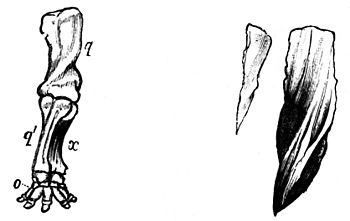urally and functionally" that they can seize and let go the fulcra on which they act; particularly is this the case in the water and in the air, the form and movement being such that the greatest results are secured with the least expenditure of force. The muscles cover the bones, in layers or strata, and run longitudinally with them, and with each other, but also at every degree of obliquity. The spiral structure and movement of bones of animals have been carefully analyzed by Dr. Pettigrew, and some of his conclusions are illustrated in Fig. 4.
Fig. 4.

Wing of Bird.—Shows how the bones of the arm (a), forearm (b), and hand (c), are twisted, and form a conical screw.

Anterior Extremity of Elephant.—Shows how the bones of the arm (g), forearm (g'x), and (o), are twisted to form an osseous screw. Cast or mould of the interior of the left ventricle of the heart of a deer. Shows that, the left ventricular cavity is conical and spiral in its nature.
The voluntary muscles of the wing, he finds, are upon the same pattern as are those of the involuntary muscles of the heart. He compared the bones removed from the forelimb of a quadruped or bird, with a cast obtained from the cavity of a hollow muscle, the left ventricle of the heart of a mammal, and found that the bones and the cast are twisted upon themselves, and form elegant screws, the threads of which run in the same direction.
Fig. 5.

Diagram, showing the figure-of-8 or double-waved track produced by the alternating of the extremities in man in walking and running.
The movement of the limbs of a quadruped is in curves, which, continued, form a figure-of-8, or a series of them; a fact in progression first pointed out by Dr. Pettigrew. Quadrupeds, says the author, walk; fishes swim; insects, bats, and birds, fly by figure-of-8 move-
